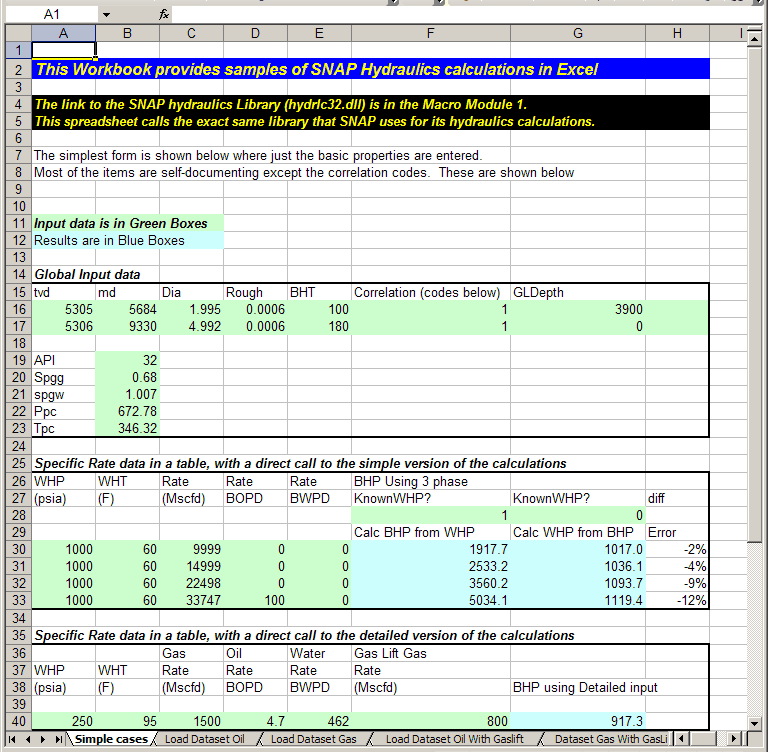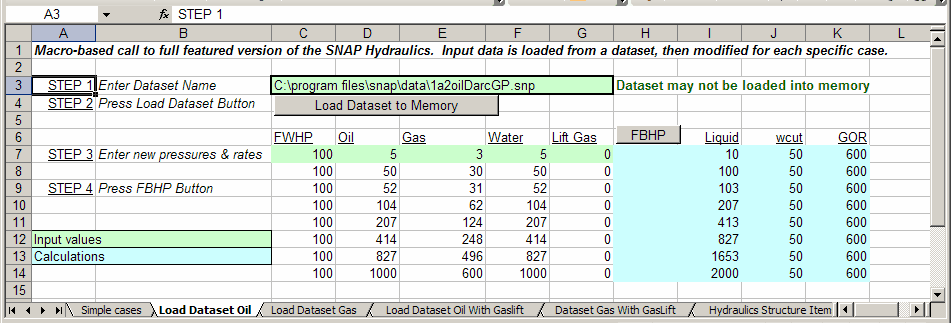|
<< Click to Display Table of Contents >> Doing Hydraulics in Excel |
  
|
|
<< Click to Display Table of Contents >> Doing Hydraulics in Excel |
  
|
Excel Hydraulics
Many SNAP routines can be called from other programs by linking to the hydra.dll, gaslift.dll and IPR.dll calculation libraries.
Several 3rd party programs call the SNAP hydraulics library and use the embedded calculations to make the complex calculations available without having to re-write that code for each program.
The simplest method of calling the SNAP hydraulics for a typical non-programmer is through the example Excel file SNAP_HYDRAULICS_FROM_EXCEL.xls .
This workbook has samples of simple direct calls to the SNAP hydraulics routines. It also has samples of more complex calls based on Excel reading a dataset, then modifying rate and other parameters within the worksheet macro.
The first tab of the spreadsheet has a few simple cases where the input is only TVD, MD, Diameter, Roughness, BHT, Correlation, and Gas lift depth. In these cases all other possible input values are assumed to match a set of typical defaults. The example shows the values calculated from wellhead to bottom-hole then back the other direction to test the result using the DPPIPE function call as in the following image.
![]()

More Complex Calls to the SNAP Hydraulics Libraries
The more complex features allow a complete set of variables to be loaded from a SNAP dataset, then selected values can be changed from within excel as in the example shown below from the second tab in the sample spreadsheet.

In this example, the dataset "C:\program files\snap\data\1a2oilDarcGP.snp" is loaded into the Visual Basic memory parameters using the Macro "LoadDataset". This internal macro is launched when the ![]() button is pressed. From that point, until the next dataset is loaded, any calls to the more detailed hydraulics routines will use the values loaded from the dataset, unless replaced through one of the hydraulics function calls, or through a visual basic macro. Pressing the
button is pressed. From that point, until the next dataset is loaded, any calls to the more detailed hydraulics routines will use the values loaded from the dataset, unless replaced through one of the hydraulics function calls, or through a visual basic macro. Pressing the ![]() button will launch a macro "runWithLoadedVariables()" that pulls in the values to the left of the FBHP column, calls the macro function "hydrlicFullMPNoOutput(MP, Out)" and returns a value to the spreadsheet. (program listing included below)
button will launch a macro "runWithLoadedVariables()" that pulls in the values to the left of the FBHP column, calls the macro function "hydrlicFullMPNoOutput(MP, Out)" and returns a value to the spreadsheet. (program listing included below)
Filling values down on the C, D, E, F, and G column will increase the number of Items run through the Macro. It is recommended that this spreadsheet be stored as a sample and then saved as your own working copy. This will not affect the macro calls or links to the libraries.
Public Sub runWithLoadedVariables()
Dim ref As String
If LoadedDataset = "" Then
ret = MsgBox("no dataset reference is loaded", vbCritical)
Exit Sub
End If
Range("b6").Value = ""
Range("h3").Value = "WORKING....."
Range("h3").Font.Color = RGB(255, 0, 0)
For Row = 7 To 10000
ref = "H" & Row
If Val(Range(ref).Value) = 0 Then Exit For
Range(ref).Value = ""
Next Row
' loop down through values and post
MP.glVolOpt = 1 ' always assume gas rate provided
For Row = 7 To 10000
ref = "C" & Row
If Val(Range(ref).Value) = 0 Then GoTo ENDSUB
MP.pressure = Range(ref).Value
If (MP.PrimaryPhase = 1) Then
MP.gas = Range("E" & Row).Value
If (MP.gas = 0) Then GoTo FAIL
liq = Range("D" & Row).Value + Range("F" & Row).Value
MP.liquid = liq / MP.gas * 1000 ' this is actually yeald for gas wells
If (liq > 0) Then
MP.WCut = Range("F" & Row).Value / liq * 100
Else
MP.WCut = 0#
End If
MP.GLRate(0) = Range("g" & Row).Value
Else ' must be oil
MP.liquid = Range("D" & Row).Value + Range("F" & Row).Value
oil = Range("D" & Row).Value ' this is actually yeald for gas wells
MP.gas = Range("E" & Row).Value ' holding area. need to load GOR
If (oil = 0) Then
MP.GOR = 99999# ' FAIL
Else
MP.GOR = MP.gas / oil * 1000
End If
If (MP.liquid > 0) Then
MP.WCut = Range("F" & Row).Value / MP.liquid * 100
Else
MP.WCut = 0#
End If
MP.GLRate(0) = Range("g" & Row).Value
End If
retval = hydrlicFullMPNoOutput(MP, Out)
Range("h" & Row).Value = retval
GoTo ENDLOOP
FAIL:
Range("h" & Row).Value = "Error"
ENDLOOP:
Next
ENDSUB:
Range("h3").Font.ColorIndex = 10
Range("h3").Value = "finished"
End Sub
Since this is a new feature, additional documentation and support will be available if this feature usage warrants additional discussion.